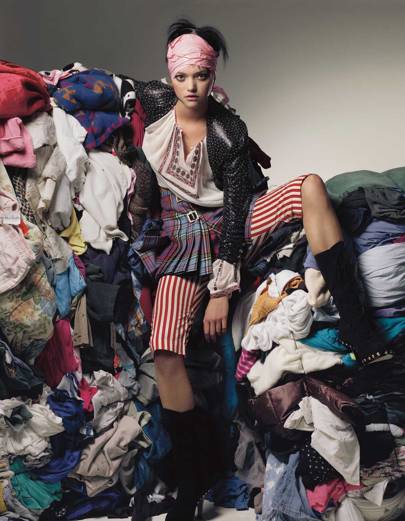ThredUP posits that the global resale market will be worth $41 billion by 2022, because “resale disruptors” like itself are growing 24 times faster than the retail industry as a whole: 49 percent year-over-year, versus two percent. This means that second-hand or thrift items will make up one third of our wardrobes in 2027.
Is this dramatic spike due to an increased interest in mindful shopping, with shoppers keen to actively cut down on consumption via second-hand acquisitions? Or are consumers just hungry for discounted designer products? With the fifth annual Fashion Revolution Week coming to a close, it seems like an apt time to investigate.
Research into what Lyst users are actually searching for reveals some home truths. Bags are the most popular pre-owned item to buy online, followed by jewellery and shoes – three categories known for their comprehensive manufacturing techniques. Customers aren’t searching specifically for “pre-owned” accessories, but for brands like Chanel and Céline, which have historically not been readily-available to buy new online (the former still only sells via its boutiques).
Searches are also trend-led. In the last three months, there has been a 62 percent increase in searches for logo pieces in response to the Nineties logomania that the street-style set is currently enjoying. Dior’s saddle bag and Louis Vuitton’s Speedy model garner the most consumer interest, while Fendi is also gaining traction, no doubt due to the hype around the return of its graphic double Fs.
Accessories have always been an affordable gateway purchase for first-time luxury shoppers, and indeed, ThredUP’s report shows that 66 percent of consumers use resale channels to buy brands that they couldn’t pay full price for. Millennials are the thriftiest shoppers, and buy resale items more than any other age group, citing sustainability as the reason for shopping second-hand. 77 percent of 18-to-24-year-olds prefer to shop from environmentally-conscious brands. But the data also showed that they are the most impulsive shoppers and discard items after one to five wears. The millennial moral and retail habits don’t match up - suggesting that green-washed consumers are merely jumping on the back of the trend du jour.

“Discussing which website you use to re-sell your clothes is now like saying, ‘Who does your hair?’” Sharon Wolter-Ferguson, CEO and founder of Hardly Ever Worn It, said. The e-tailer, which rebranded itself as HEWI after members started using “hewi” as a verb, has seen a growth of 1,000 percent in four years and launched a sister site, Hewistreet.com, a week ago to keep up with the demand for buying, selling and swapping contemporary brands, such as Sandro and The Kooples.
Cora Hilts, co-founder of sustainable luxury etailer Rêve En Vert, thinks the mass rise in interest around sustainability roots back to Blue Planet II. The finale gave an unflinching look at the impact of human activity on marine life, and ended with a conservation rallying cry from David Attenborough. “It was a real wake-up call to people that we have individual responsibilities towards our consumption habits,” Hilts says of the 30 percent month-on-month traffic increase Rêve En Vert has received since the show aired.
Ceanne Fernandes Wong, Vestiaire Collective chief marketing officer and vice president, agrees: “We're seeing customers evolve and become more mindful about their consumption habits. As brands and their products are becoming more visible via the likes of Instagram, everyone is seeing the same thing and individuality is standing up against this sense of homogeny.” One million new members joined Vestiaire Collective last year, bumping up its resale community up to seven million members globally.
Circular clothing economy has always been a part of Vestiaire Collective’s DNA, but it’s currently carrying out a project to analyse how internal operations within the business can operate more sustainably. Later this year it will sign the CFS 2020 Circular FashionSystem Commitment Letter, and packaging will be its first priority. HEWI is also transitioning to eco-friendly packaging, and customers have the option of donating a portion of the profits from their sales to charities.
Designer resale shoppers seem to be going through the motions of compiling guilt-free wardrobes, but if millennials are throwing items away after a handful of wears, it doesn’t matter how many consignment sites are promoting the "buy less, but better" policy. Stella McCartney, a designer known for her staunch activism, concurs: “It’s absolutely crazy that only one percent of clothing is actually recycled,” she told Vogue.
McCartney recently partnered with the RealReal, one of the top three resale websites alongside ThredUP and Poshmark, to promote fashion sharing. But, there's only so many times she can reiterate her outrage at fashion’s environmental footprint. Consumers need to get their stories straight, and Fashion Revolution Week proves there’s no time like the present to start shopping sustainably in the first place.

No comments:
Post a Comment